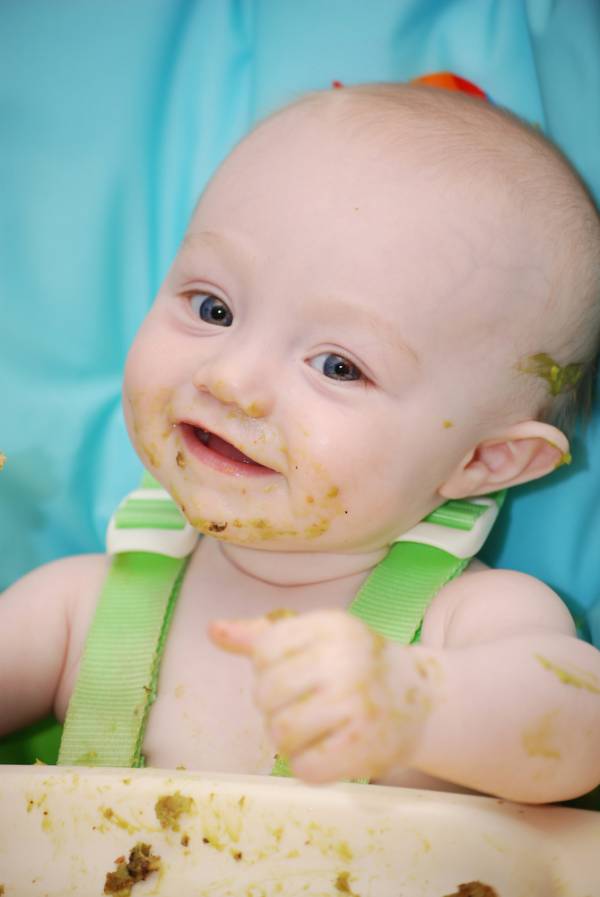I was in Babies ‘R’ Us a few weeks ago to get a new car seat and it suddenly struck me that having babies has become really complicated. All babies really need is food, some form of butt covering to prevent stains on your carpet, and clothes that are going to get ruined anyway. Parents today get to choose between ten types of baby wipe warmers and a whole aisle of pacifier varieties.
The same goes for food. The baby food industry brings in $1.25 billion dollars a year in the United States alone. The average American baby consumes almost three times as much baby food in one year as a baby born in western Europe. My first child was born in Belgium, and there was a striking difference between the food recommendations we received there and those we received when my second child was born in the U.S. The baby food aisle was also much smaller in Belgium.
If you follow a paleo diet, you’ve already eliminated processed foods from your own diet. If you have a little one, you probably want to start her off right as well. Baby food and baby cereal are processed foods that contain starchy fillers, added sugars, and high amounts of sodium. They’re also overpriced, especially the organic brands. You can easily make your own baby food with whole foods and without the undesirable ingredients. And in my experience, babies love simple, whole foods – especially if that’s what they’ve been eating from day one.
I started my baby food-making journey with the usual fruit and vegetable purees, and those foods have remained the primary staples of our childrens’ diets. But I’ve also gotten a bit more adventurous over the years, especially since I discovered the paleo diet and more traditional dietary theories. Here are five of my favorite paleo foods for babies and toddlers. If you’re currently pregnant, you can start feeding baby these foods now by adding them to your pregnancy diet:
1. Liver
“… liver has ranked above all other offal as one of the most prized culinary delights. Its heritage is illustrious – whether savored by young warriors after a kill or mixed with truffles and cognac for fine patés de foie gras.” -Margaret Gin and Jana Allen
Liver might sound unappetizing to many adults, but babies love it. I started feeding my daughter liver after I found out her iron levels were low, and within a few weeks they were back to normal. Liver is also an excellent source of vitamin A, and contains vitamin C and protein for an added benefit. Liver is especially beneficial during the weaning stages. Combine liver with healthy probiotic foods, like a bit of sauerkraut or kimchi, to make the liver more digestible.

2. Bone Marrow
“If you find yourself turning progressively more feral as the marrow disappears from the bone, don’t worry … When it comes to getting the last delicious bits of bone marrow, total paleo reenactment is the only justifiable course of action.” –Mark Sisson
One day I was attempting to finish up a batch of bone broth but my nine-month-old was making it difficult. I put her in her high chair and gave her one of the bones to chew on for awhile since she was teething. Five minutes later I turned around to find her literally sucking the marrow out of the center of the bone. If you make broth regularly, remove some of the marrow bones early and scoop out the marrow for your baby. Otherwise, you can roast the marrow bones in the oven and serve them fresh with a bit of butter.
3. Salmon
“I have been impressed with the superior quality of the human stock developed wherever a liberal source of sea foods existed.” -Weston A. Price
Salmon and salmon roe are considered to be sacred foods in many cultures. They are excellent sources of essential fatty acids like EPA and DHA, as well as vitamin D, which is hard to find in food sources. Mix up some salmon roe, flaked salmon, and avocado for a good dose of healthy fat.
4. Egg Yolks
“I’m frightened of eggs, worse than frightened, they revolt me. That white round thing without any holes … have you ever seen anything more revolting than an egg yolk breaking and spilling its yellow liquid? Blood is jolly, red. But egg yolk is yellow, revolting. I’ve never tasted it.” -Alfred Hitchcock
Start your baby off young to avoid an egg yolk aversion. Egg yolks are an excellent source of omega-3 fatty acids, and are also easy to prepare. The white is harder for babies to digest, so I stick with egg yolk until my children are about a year old. If possible use eggs from free range chickens or find a local farm that provides fresh eggs.

5. Avocados
“In this single delectable fruit are combined the protein of meat, the fat of butter (but much more wholesome!), the vitamins and minerals of green vegetables, the flavor of nuts, a six course dinner.” -Gaylord Hauser
Avocados were both of my daughters’ favorite baby foods. They were also mine, since they’re so easy to prepare, and also a good source of healthy fat and protein. If you follow baby-led weaning practices, avocados are a perfect starter food. Just scoop it out, mash it up, and serve with a bit of salt or mixed with breastmilk or formula. Be warned: it does get messy. In my experience, the picture on the right is very realistic.
Try these foods out with your little one and see how she reacts. You may find she devours them with a voracity that would put any caveman to shame. Even better, she’ll grow up with a robust appreciation for liver and bone marrow, which in my book is a parenting win.
Photos courtesy of Shutterstock.






